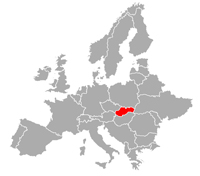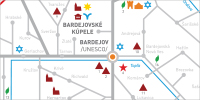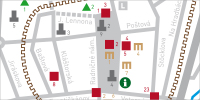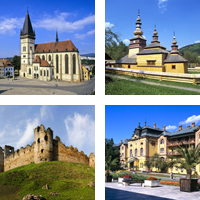 
                    |
The beautiful Basilica of Saint Egidius belongs to one of most precious medieval gothic structures in Bardejov. From archeological point of view, it belongs to the most important monuments in Slovakia. Its eleven gothic painted altars are of world-wide importance.
The church’s beginnings date back to the thirteenth century. The first source that mentions its existence is a document from 1247 issued by King Bela IV. The text makes a reference to Cistercian monks who originally came from Koprziwnica in Poland and erected a cloister dedicated to Saint Egidius. Due to sudden changes, however, the Cistercians had left the place in the second half of the thirteenth century. In their stead came the German colonist during the early fourteenth century.
The building of the church began in the middle of the century. The principal and the side aisles were built in 1415. The work on the tower, which housed the second clock in all of period kingdom of Hungary, dates to 1420 – 1427. The church is recorded in 1427 as consisting of three aisles and simple arcades. The year 1448 saw further modifications and additional construction work on the church. Magister Nicolas Lapicid supervised the work on the presbytery. However its arch collapsed, most probably due to a structural weakness.
Magister Stephen from Košice was called upon in 1464 to supervise repair works on the building. Stephen was simultaneously involved in the construction of the Saint Elisabeth’s church in Košice. The famous royal magister oversaw work on the sanctuary, the choir, the sacristy and the gallery with the chapel of Saint Catherine – also known as oratorium of king Matthias. The work on the sanctuary was finished by 1464 and when a new arc was constructed. A year later, Stephen built a unique stone pastoforium, situated between the sanctuary and the main isle. The pastoforium is regarded as one of the most important works of its kind.
In 1466 Magister Jacob of Sącz built the principal gothic altar positioned in the sanctuary. However, nowadays only the statue of Saint Egidius remains of it. The statue is placed in the chapel of Virgin Mary. The bronze baptistery is of the same period.
|
During the time span of 1482 – 1486 and under the supervision of local magister Urban three new chapels were built in the southern part of the church – Virgin Mary’s, Saint Elisabeth’s and Saint Andrew’s. In 1486 the locals had also cast a bell called John. Urban began construction of the church tower, which was finished by another magister John Stemasek of Bavaria in the period of 1486 – 1494.
Later decades did not saw any remarkable architectural development. Only in 1580 the Italian brothers Luigi and Bernardo Pela from Lugano modified part of the church in renaissance fashion, though this enhancement was limited only to its southern facade. In 1584 Polish bell-founder John of Tarnów cast one of the largest bells in Slovakia – the four ton Urban. In the middle of the seventeenth century the gothic altar was replaced by an early baroque piece.
Several natural disasters took its toll on the church over the centuries. The majority of the damage was caused by earthquakes and fire. An earthquake of 1725 destroyed the tower and in 1836 another one broke the church’s wall at three points. The fire of 1774 caused a complete breakdown of the tower and the building was without one until 1898. The catastrophic fire on Easter Monday in 1878, which almost burned the whole town to the ground, also brought major reconstruction attempts.
Since 1878 architect Emerich Steindl led a reconstruction in the spirit of period purism. Thus the renaissance architectural features were removed and replaced by neo-gothic additions. The church’s tower, the pillars, the main isle’s walls as well as chapels’ arches were renewed in 1898. Furthermore, a neo-gothic principal altar and a pulpit were also added to the interior. The work took twenty years to accomplish after which the church took its present shape. A massive organ was brought to the choir in 1906. Due to its unique form and function it became one of the church’s dominants.
The last decades saw further restoration work. During the early nineties the medieval bells John and Urban broke and were replaced by modern copies bearing the same names. The originals are on display outside the building.
|
The church tower is 72 meters high and ranks among the tallest in Slovakia. It contains the replica bells of Urban and John as well as Signum dated to 1625. The tower serves as favorite vista point for tourists.
Aside from its architectural value the church is also fascinating by its internal composition. The most dominant feature, aside from the 17 meters tall neogothic altar of 1878 from Prague master Moricz Hölzel, is a collection of eleven gothic winged altars dated 1440 – 1520. Most of the pieces remain standing at their original location. Each altar was tended by one of the Bardejov’s town guild.
The altars, upkeeped by the local guilds, are the following: The altar of Saint Andrew (1440 – 1460), Saint Barbara (1450 – 1470), Saint Elisabeth of Hungary (1480, maintained by the tailor’s guild), Virgin Mary, known before as Saint Ann’s (1485), another altar of Virgin Mary known as Veronica Mager’s (1489), the Man of Sorrows (1500 – 1510, upkeeped by the carpenter’ guild), Altar of the Holy Cross (1480 – 1490, dedicated to the farmer’s guild), Altar of Saint Erasmus and Saint Nicolas (property of the potter’s guild) Saint Apollonia (1485, belonging to sieve-makers), Altar of Pieta (1480 – 1490, bricklayer’s and stone mason’s altar) and last but not least the altar of Nativity of Jesus (1480 – 1490, maintained by the weaver’s guild). The latter is ranked among the most beautiful and precious winged altars in Slovakia.
Another valuable pieces of art are the following: a group of statues displaying Golgotha dated to the fifteenth century, a stone sanctuary of 1465, sixteenth century Corpus Christi from Master Paul of Levoča, a bronze baptistery of 1485, gothic benches, fifteenth century door and a chandelier, seventeenth century renaissance benches, stone tombstones of sixteenth and seventeenth century and other miscellaneous liturgical items. The early baroque principal altar of 1655 was removed during the era of the gothic revival. However a part of the altar – a period copy of the painting showing the piercing of Jesus’ side with a lance – Is still preserved.
The Saint Egidius’ church was elevated to a Basilica minor and registered into UNESCO World Heritage in 2000.
More information:
wikipedia.org
Translated by:
Mgr. Samuel Beňa, M.A.
|





















